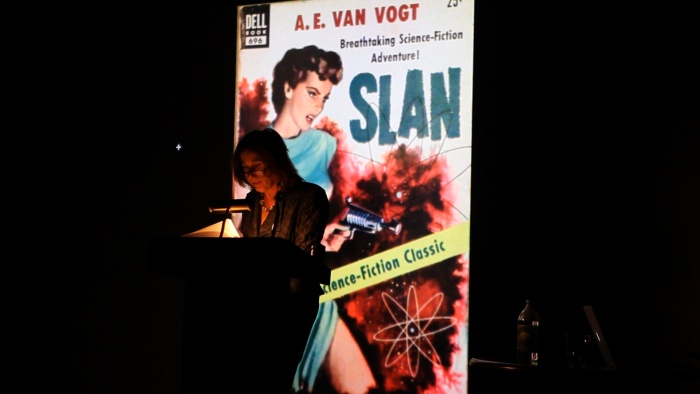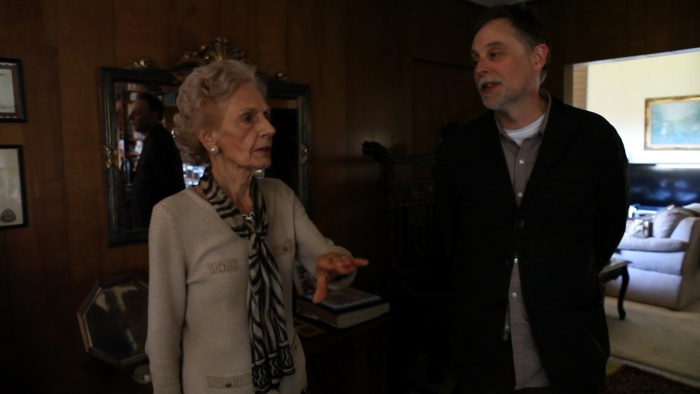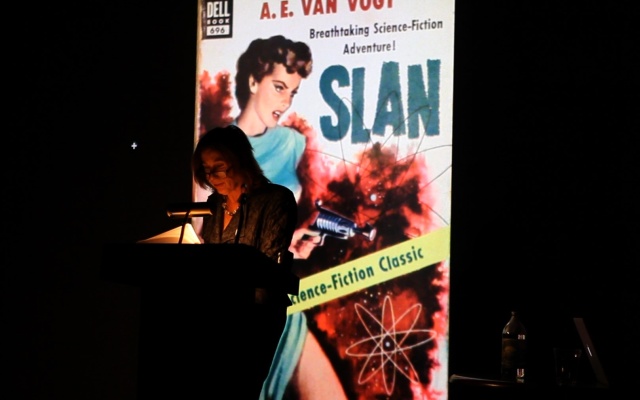Chris Kraus: The Book Lovers have asked us to talk about fictocriticism – the class we co-taught, with Malik Gaines – at the San Francisco Art Institute more than ten years ago. And I can’t remember a thing! Except for the plane rides up and back, leaving Burbank at 6 in the morning and returning the same evening around 9 or 10, always very relieved and feeling like I’d gotten away with something. Recently I ran into Lauren Woods, one of our ex-students. She’s living in Dallas, Texas now and thankfully still making art, and teaching in an art program there. In a sense, I don’t think it matters what a writer or artist calls the classes they teach – they’re always teaching the same thing. You’re teaching yourself, or rather, your process.
“Fictocriticism” at the time seemed like a good way to describe something we shared in our work. Our novels are very informed, in different ways, by research and concerns beyond the scope of “character” and “plot.” 
Chris Kraus wygłaszająca w Amboy wykład fabularyzowany "Amboy: American Artist" autorstwa swojego i Marka von Schlegella. Zdjęcie: Frances Scholz, 2015.
Mark von Schlegell: When we got together to propose the class, I do remember you saying, as if it were the most natural thing: “We will call it fictocriticism, of course.” This seemed entirely sensible and entirely crazy at the same time, which I think was part of the point. Naturally, I immediately agreed. I didn’t think of it in cutting-edge terms, but rather completely outside of the moment. The reading might have been the collection: The Artist as Critic by Oscar Wilde. At the time you had recently published Aliens & Anorexia or so I believe. Could we say that, so far, that is the most critically oriented of your novels? For me as a reader, the way that book blended the method of I Love Dick with pure criticism of the sort you, and perhaps we, as art writers of this moment dreamed we could write, remains special. I am sure it gave us a spur?
CK: I was lucky, writing Aliens & Anorexia, that I got lonely that winter in East Hampton and fell into the kinky sex phone relationship with the New Zealand movie producer. When I took the time off and rented the house, I seriously thought I was going to be writing a straight academic critical book about Simone Weil and Paul Thek. I had some outtakes from I Love Dick to start with, but no Dick to write to. The combination of going to the writer Peter Matthiesson’s Zen center in Bridgehampton, regularly, and waiting for these intense afternoon calls from Namibia, where the producer was shooting a film with Angelina Jolie, came into the book and forced me to write it in real-time. But the idea of seeing writing, including criticism, as a big room with the windows all open? That seems important. I learned that from David Rattray, a poet whose critical writing feels indelible, because his thought is so felt, and so physical. You’d written the PhD thesis on 19th century American realism that you’re elaborating now in Realometer before you wrote novels. Your novels are all very plotted, but the plot feels almost like a gift to the reader, whereas the driving force is something else, more poetic and critical. “Critical” in the sense of, a lot of content – physics, Shakespeare, biology – this isn’t exactly a question, but don’t you see that as one of the elements in your writing – finding a form, because a lot of what drives it is external content. Maybe we could use the phrase “external content” in place of criticism. Because what passes as regular contemporary literary fiction is just so solipsistic.
MVS: On the surface our work is so entirely different, yet I remember at times writing in tandem, trading chapters as I built up Venusia. This was my first novel, and I was writing art criticism at the same time in that amazing art-writing environment that was turn-of-the-century Los Angeles. I had studied literature and earned a PhD just out of interest, really. My plan had always been to write fiction. But my world is in large part literary. As you say I’ve had the driving force to go critical, non-fictional, to have no boundaries with fiction.
But it remains blatantly textual, and unconstrained. And this is one thing that our texts share very closely and reveals how similar our attitudes are; I’ve always been struck by the play of outside textual fields within your texts.
In Aliens the use of Weil, Gavin, etc., join the strains of Defoe and older writings, French philosophy, and abduction narratives – sometimes simultaneously. The tone of I Love Dick emerges into a psychedelic literary blend, a wonderful portrait of the “world” of a writer finding herself; this strikes me as more open to the outside than a strained stenographical “realism.” One thing I admire about Summer of Hate is that this impulse has been contained in the architecture of the book, as if to lure the enemy in. Chris Kraus literature now entwines with noir, and the outside non-literary world (spoiler alert) encounters and is itself transformed by Catt’s fantasy world.
Those prophetic Sheriff Joe Arpaio sections remain especially exemplary of how the novel can serve reality in the era of “fake news.” Working on Realometer Re-Loaded, I realized with Poe – they say that the death of his mother, a beautiful young woman, is at the center of all his work – but it’s not true. Pym, his novel, The Purloined Letter, and many of his most interesting and critically examined texts have no such imagery. But they all are about reading and writing. An orphan, literature was his family. His writing, which refuses to escape the textual, to apply to the outside world except as nemesis and deconstruction, nevertheless critically transforms the outside world, because it takes so much of the world in it through other texts. I can’t help but identify you with a nonjudgmental, postmodern attitude inherited from Acker and others, that sense that everything in a book is a piece of the outside world, thus books themselves are pieces of the world and the responsibility of the novelist is toward that pluralism of writing in and outside the self. 
Lydia van Vogt i Mark von Schlegell w Amboy. Zdjęcie: Frances Scholz, 2015.
CK: I totally agree. I don’t think that disposition is generational. It’s more, maybe, poetic – it’s no coincidence that both of us grew up around the poetry world. Teaching a class like “fictocriticism,” or any of the classes we teach – that is much more accessible to artists than, say, a short story class. The aesthetic values of the art and poetry worlds are more closely aligned. What’s taught now as literary fiction rings false to artists. Your classes at Staedelschule are mythic ... kind of an example of “fictocriticism” and beyond. When I visited a few years ago, you talked for over an hour ... digressive, free-associating, it was like Art Bell’s late-night paranormal radio show. And you’ve been staging the classics –
MVS: Chris, the class has become explicitly mythic, with Jack Brennan introducing myth-writing in seminar last semester, and now the Robert Graves House inviting us to propose some sort of Pure Fiction residency in Deia, Mallorca. Though Art Bell is gone, in other words, the paranormal remains. The artists working with fiction and writing that I collaborate with in Frankfurt are uniquely and even perversely focused on things like self-publication, performance, anti-distribution, and even large-scale theatrical collaboration, which they can fall into immediately and in large numbers. This puts them much more in alignment with what we have experienced as the poetry world than the art world – yet still a thing apart. Meanwhile many are versed in poetry; ficto-critics like you and I are now followed by real poets into the alternate economy of the art world. Art-for-art’s-sake, like Art Bell, has all but disappeared. It’s for all of us, no?
CK: I remember you comparing catalog-essay writing to pulp magazine writing in the 20th century – a passably lucrative side-job for a writer. And it’s true! You actually wrote a whole novel, New Dystopia as an alternative catalog for a museum show in Bordeaux. The art world is sick of its rhetoric. Since everyone agrees that criticism is a cynical exercise that exists to add value to the art object, why not at least be amused? And so cynicism becomes an opportunity for writers to do something good.
BIOS
Chris Kraus is a writer, filmmaker, and co-editor of the publishing house Semiotext(e). She is the author of four novels, among which I Love Dick (1997), which has been dubbed "a fusion of gossip and theory" and, most recently, After Kathy Acker – A Literary Biography. A new collection of her art writing, Social Practices, will be published by Semiotexte in Fall 2018. She lives in northern Minnesota and Los Angeles.
Mark von Schlegell is the author of various novels, shorter fictions, art texts, and critical writings, including Sundogz (Semiotext(e), 2015) and Realometer Re-Loaded, forthcoming in 2018 as an artwork from Galerie Jan Kaps, Cologne. Born in the USA, he now lives in Cologne, Germany.
* Cover photo: Chris Kraus delivering the fictional lecture "Amboy: American Artist" by Chris Kraus and Mark von Schlegell in Amboy by Frances Scholz, 2015.



